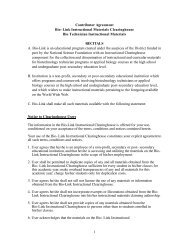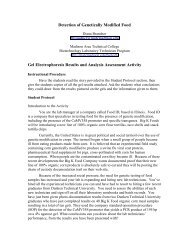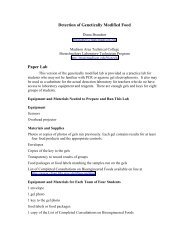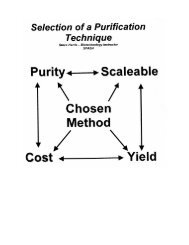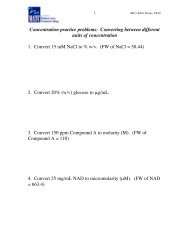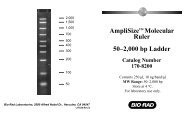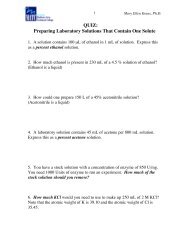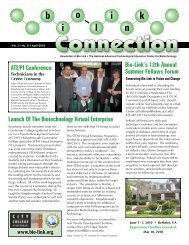TECHNICAL
Protein Concentration and Diafiltration by Tangential Flow ... - Bio-Link
Protein Concentration and Diafiltration by Tangential Flow ... - Bio-Link
- No tags were found...
Create successful ePaper yourself
Turn your PDF publications into a flip-book with our unique Google optimized e-Paper software.
DefinitionsTransmembrane Pressure (TMP) is the average applied pressure from the feed to the filtrate side ofthe membrane.TMP [bar] = [(P F + P R )/2] – P fPressure Drop (∆P) is the difference in pressure along the feed channel of the membrane from the inletto the outlet.∆P [bar] = P F – P RConversion Ratio (CR) is the fraction of the feed side flow that passes through the membrane tothe filtrate.CR [-] = Q f /Q FApparent Sieving (S app ) is the fraction of a particular protein that passes through the membrane to thefiltrate stream based on the measurable protein concentrations in the feed and filtrate streams. A sievingcoefficient can be calculated for each protein in a feedstock.S app [-] = (concentration in filtrate, C f )/(concentration in feed, C b )Intrinsic Sieving (S i ) is also the fraction of a particular protein that passes through the membrane to thefiltrate stream. However, it is based on the protein concentration at the membrane surface. Although itcannot be directly measured, it gives a better understanding of the membrane's inherent separationcharacteristics.S i [-] = (concentration in filtrate, C f )/(concentration at membrane wall, C w )Retention (R) is the fraction of a particular protein that is retained by the membrane. It can also becalculated as either apparent or intrinsic retention. Retention is often also called rejection.R app [-] = 1 – S app or R i = 1 - S iFiltrate Flux (J f ) is the filtrate flow rate normalized for the area of membrane [m 2 ] through which it ispassing.J f [L m -2 h -1 ] = Q f /areaMass Flux (J m ) is the mass flow of protein through the membrane normalized for the area of membrane[m 2 ] through which it is passing.J m [g m -2 h -1 ] = Q f x C f /areaVolume Concentration Factor (VCF or X) is the amount that the feed stream has been reduced involume from the initial volume. For instance, if 20 L of feedstock are processed by ultrafiltration until 18 Lhave passed through to the filtrate and 2 L are left in the retentate, a ten-fold concentration has beenperformed so the Volume Concentration Factor is 10. In a Fed-Batch concentration process, where thebulk feedstock is held in an external tank and added to the TFF operation continuously as filtrate isremoved, VCF should be calculated based only on the volume that has been added to the TFF operation.VCF or X [-] = Total starting feed volume added to the operation/current retentate volumeConcentration Factor (CF) is the amount that the product has been concentrated in the feed stream.This depends on both the volume concentration factor and the retention. As with the VCF, for a Fed-Batchconcentration process, calculate CF based only on the volume of feedstock added to the TFF operation.CF [-] = Final product concentration/Initial product concentration = VCF( R app)A Diavolume (DV or N) is a measure of the extent of washing that has been performed during adiafiltration step. It is based on the volume of diafiltration buffer introduced into the unit operationcompared to the retentate volume. If a constant-volume diafiltration is being performed, where theretentate volume is held constant and diafiltration buffer enters at the same rate that filtrate leaves, adiavolume is calculated as:DV or N [-] = Total buffer volume introduced to the operation during diafiltration/retentate volume4





